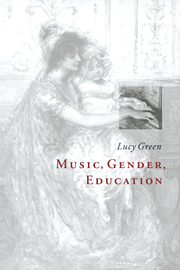Book contents
- Frontmatter
- Contents
- Acknowledgments
- 1 Introduction
- PART I MUSICAL MEANING AND WOMEN'S MUSICAL PRACTICE
- PART II GENDERED MUSICAL MEANING IN CONTEMPORARY EDUCATION
- 6 Affirming femininity in the music classroom
- 7 From affirmation to interruption of femininity in the music classroom
- 8 Threatening femininity in the music classroom
- 9 The music curriculum and the possibilities for intervention
- Bibliography
- Index
7 - From affirmation to interruption of femininity in the music classroom
Published online by Cambridge University Press: 20 November 2009
- Frontmatter
- Contents
- Acknowledgments
- 1 Introduction
- PART I MUSICAL MEANING AND WOMEN'S MUSICAL PRACTICE
- PART II GENDERED MUSICAL MEANING IN CONTEMPORARY EDUCATION
- 6 Affirming femininity in the music classroom
- 7 From affirmation to interruption of femininity in the music classroom
- 8 Threatening femininity in the music classroom
- 9 The music curriculum and the possibilities for intervention
- Bibliography
- Index
Summary
GIRLS AND BOYS MAKING MUSIC! TEACHERS' AND PUPILS' PERCEPTIONS
In the last chapter I concentrated almost entirely on the discourse surrounding the musical practices of girls in schools. Here, I will continue to invoke that discourse as a background to my discussion. Against this background, I will examine ways in which teachers and pupils wrote and talked about those areas of school musical life which girls are seen to avoid, but around which boys are perceived to congregate.
Attitudes
Teachers' views of girls' ‘enabling attitudes’ towards music, as described in Chapter 6, contrasted strongly with their characterisations of boys' attitudes. Whereas girls were seen to use music to express their feelings, to be cooperative and persevering in their musical practices, boys were understood characteristically to denunciate the majority of musical activities that are on offer in the school. The teachers saw this denunciation as being expressed in several ways, of which four notable ones are as follows. First, boys prefer sport to music, a choice between the two being a frequent necessity in schools where they often compete for extracurricular time. Secondly, boys create and succumb readily to heavy peer-group pressure against school music. Thirdly, they lay emphasis on what is musically ‘fashionable’ or ‘in at the moment’, which by definition does not include music that is in the school curriculum. Fourthly, they avoid certain musical activities for the reason that these are seen to be ‘cissy’ and ‘un-macho’. I have reproduced all the relevant comments below. This is again partly in the interests of accurate representation, and also because I find that the build-up of comments, the independent reiteration of similar fundamental notions by so many people, provide the best available illustration of the workings of discourse within common sense.
- Type
- Chapter
- Information
- Music, Gender, Education , pp. 168 - 192Publisher: Cambridge University PressPrint publication year: 1997



